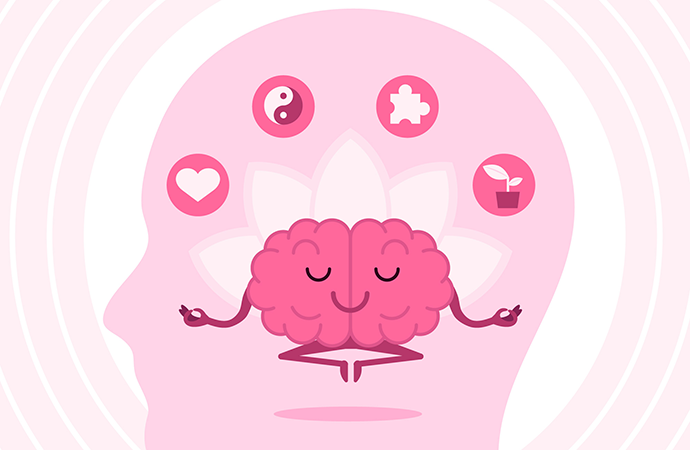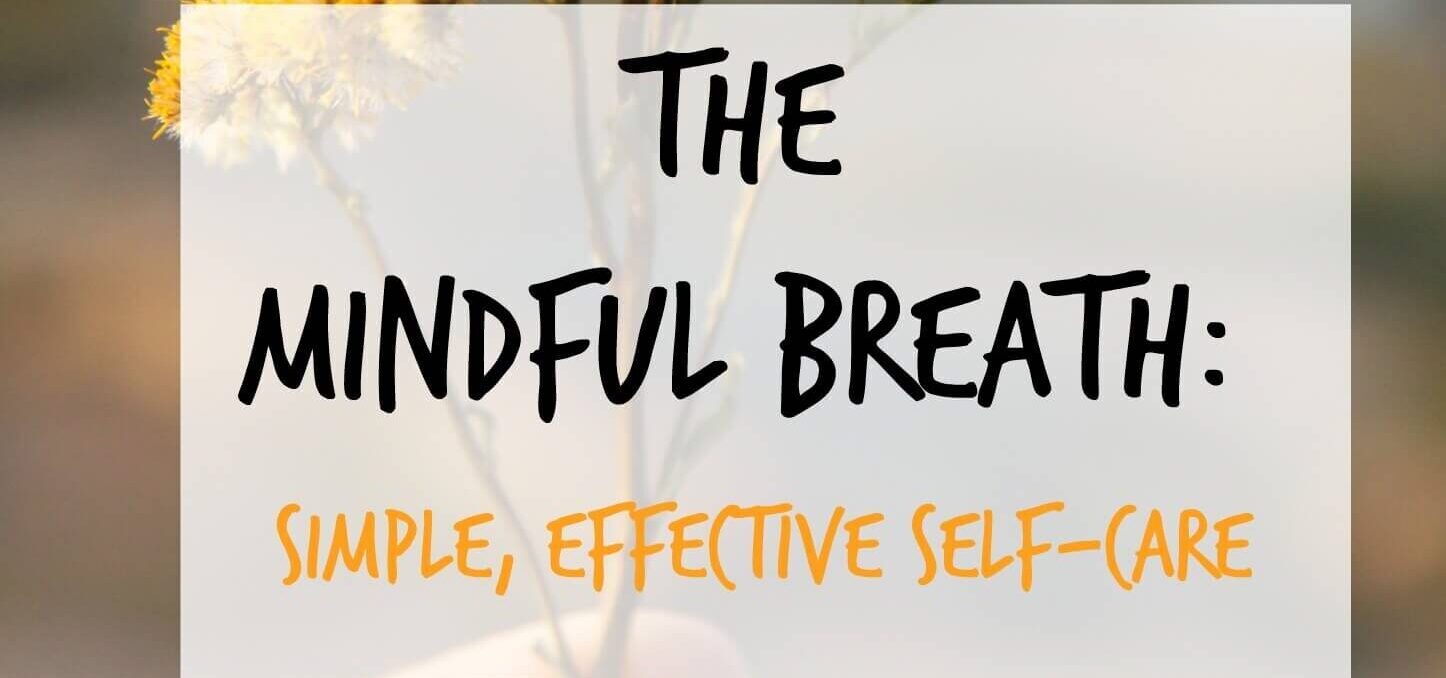
Self-care is the practice of taking an active role in protecting our own well-being, pursuing happiness, and having the ability, tools, and resources to respond to periods of stress so that they don’t result in imbalance and lead to a health crisis. Self-care means asking yourself what you need, and following through on the honest answer, it can be as simple as getting to bed earlier on a work night.
Why Is Self-Care Important?
Self-care can be an intervention tool that keeps you from being completely sucked into the vortex, saving you when you find yourself standing on the precipice gazing into the dark abyss.
A Self-Care Plan is a fail-safe, created by you, and filled with your favorite self-care activities, important reminders, and ways to activate your self-care community. Here’s why it’s important to create your own Self-Care plan:
 1. Customizing a Self-Care Plan is a preventative measure. By designing a roadmap that is unique to you, in moments when you’re NOT in crisis, you’re directing your best self to reflect on what you may need (and have access to) in your worst moments. The reality is that only YOU know how intense your stress levels can get and what resources are available to you.
1. Customizing a Self-Care Plan is a preventative measure. By designing a roadmap that is unique to you, in moments when you’re NOT in crisis, you’re directing your best self to reflect on what you may need (and have access to) in your worst moments. The reality is that only YOU know how intense your stress levels can get and what resources are available to you.
2. Having a plan takes the guesswork out of what to do and where to turn in moments of crisis. From a mindfulness point of view, it helps you respond instead of react to the situation at hand. When you have a plan in place, you’ll feel more in control of your circumstances and life won’t feel quite as chaotic.
3. A Self-Care Plan helps you stay the course. You’ll find it far easier to stick to your personal care strategy and avoid falling into the trap of making excuses. Having a plan helps you establish a routine, ensuring that you and your self-care partners don’t wind up in isolation.
The 7 Pillars of Self-Care
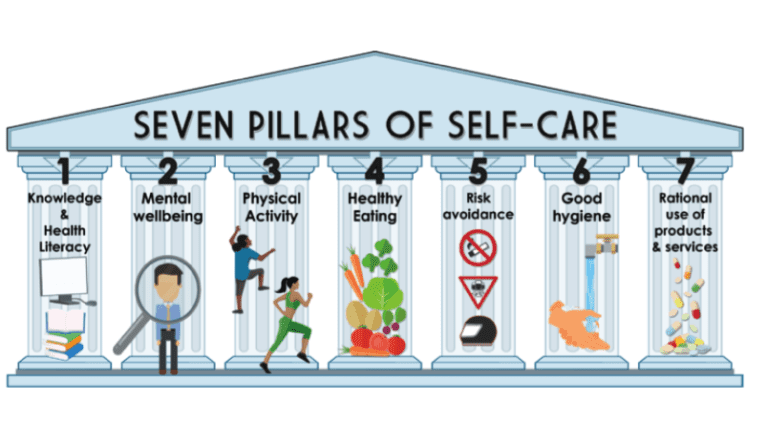 1.Health literacy – includes: the capacity of individuals to obtain, process and understand basic health information and services needed to make appropriate health decisions.
1.Health literacy – includes: the capacity of individuals to obtain, process and understand basic health information and services needed to make appropriate health decisions.
2.Mental Wellbeing – includes: knowing your body mass index (BMI), cholesterol level, blood pressure; engaging in health screening.
3.Physical activity – practicing moderate intensity physical activity such as walking, cycling, or participating in sports at a desirable frequency.
4.Healthy eating – includes: having a nutritious, balanced diet with appropriate levels of calorie intake.
5.Risk avoidance or mitigation – includes: quitting tobacco, limiting alcohol use, getting vaccinated, practicing safe sex, using sunscreens.
6.Good hygiene – includes: washing hands regularly, brushing teeth, washing food.
7. Rational and responsible use of products, services, diagnostics and medicines – includes: being aware of dangers, using responsibly when necessary.
Self-Care Practices to Use Every Day
1. Stick with my normal, daily meditation practice. It’s easy to lose track of time when the days blend into one another, but self-care is important now more than ever. Throw away the excuse “I don’t have time” —all you seem to have is time, you just need to remain disciplined.
2. Maintain contact virtually by creating a schedule. Now is a great time to make sure that you check on the ones who matter to you, and those who you rarely get to see in person. However, it’s very easy to lose track of time—especially across time zones—so having a set schedule of times to check in, hang out and even eat “dinner” together can help to restore some social structure to the day.
 3. Get outdoors. If you are blessed to live in a place where there are parks or waterfronts (that are not closed during the pandemic) and you can access them with walks, runs, and bikes, it’s a blessing that should not be squandered. Each day commit to getting outdoors and moving for at least an hour, including taking a barefoot walk on grass.
3. Get outdoors. If you are blessed to live in a place where there are parks or waterfronts (that are not closed during the pandemic) and you can access them with walks, runs, and bikes, it’s a blessing that should not be squandered. Each day commit to getting outdoors and moving for at least an hour, including taking a barefoot walk on grass.
4. Give yourself permission to cry. This is actually a important point on the usual Self-Care Plan, which seemed appropriate to migrate over in these times. You will inevitably feel sad, disheartened, or downright hopeless at times, but also know that giving yourself permission to feel these emotions fully and turn towards your suffering, will help release any pain or tension and help see the sun through the clouds once again.
5.When all else fails, ask myself: “What do I need at this moment?” This should be your default question—the one you immediately ask yourself when you sense that you are not feeling right, physically or mentally. Just pause, take a long, slow deep breath and ask yourself this question. In this space between, you should always find the answer.
6. Be a friend to yourself. As corny as that may sound, it’s a trick which is incredibly useful. When you notice you’re being hard on yourself over a problem, imagine a dear friend coming to you with the same problem. How would you respond? How would you offer support? What would you say? How would you regard your friend? Now try giving these responses to yourself.
MINDFULNESS MULTIPLIER EFFECT™
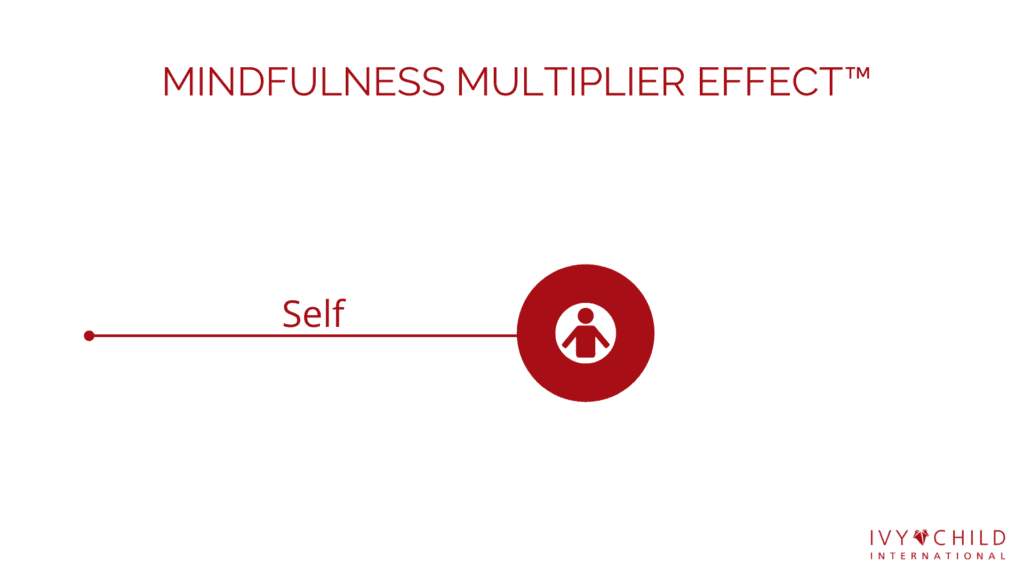 At the heart of Ivy Child’s mission, we believe that when you provide any individual access to learn and practice mindfulness, it not only enhances their direct well-being, it also ripples out to benefit all of those in their outer world.
At the heart of Ivy Child’s mission, we believe that when you provide any individual access to learn and practice mindfulness, it not only enhances their direct well-being, it also ripples out to benefit all of those in their outer world.
Everything begins from self, from the inside, you are the epicenter. How your emotional energy, thoughts, words, and actions may affect those whom you interact with, and in turn how that shifts their emotional energy, thoughts, words, and actions, and how that continues to spread outward with each person whom they interact with, and so on.
Seven Days Seven Ways of Practicing Self Mindfulness
Day 1: Notice Breathe Allow Act
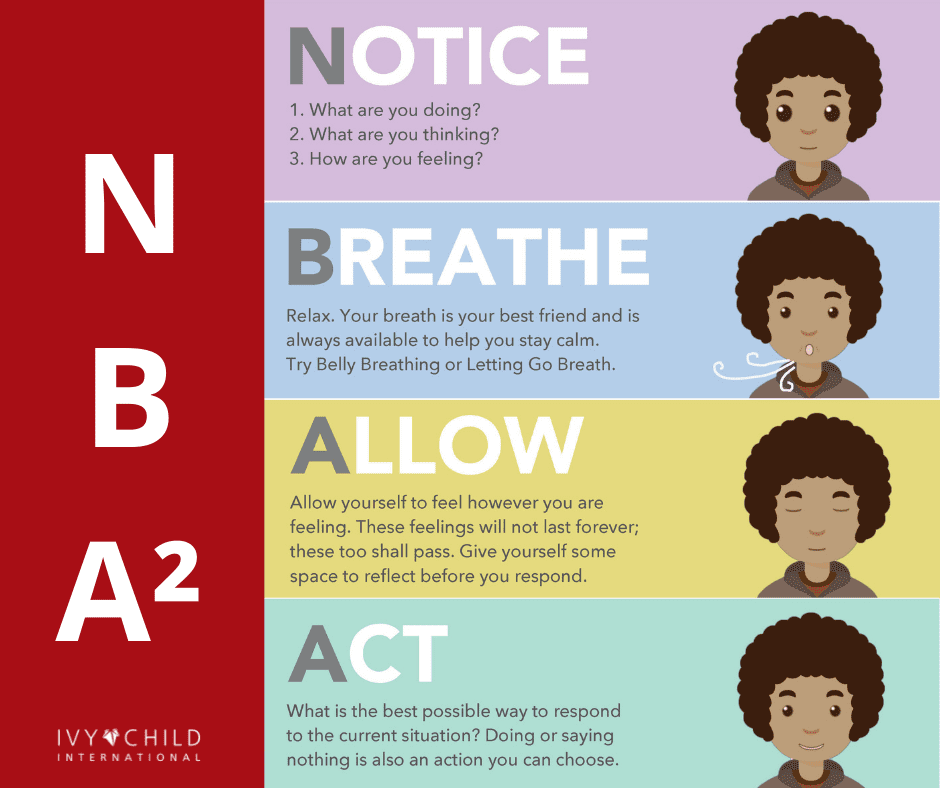 This simple mindfulness practice, helps us notice, breathe, allow, and take positive action. Follow along to widen the gap between the impulse to react and choosing how you want to respond.
This simple mindfulness practice, helps us notice, breathe, allow, and take positive action. Follow along to widen the gap between the impulse to react and choosing how you want to respond.
When we experience unpleasant feelings or thoughts—we feel stressed or anxious or uncomfortable in some way—instead of just reacting or trying to push those thoughts or feelings away, we have another option. We can notice the feelings and the thoughts, breathe into them, and allow them to be there. We may feel unsettled, but by allowing our discomfort, stress, anxiety, or whatever our experience is to be exactly as it is, we let go of any unnecessary tension and allow the experience to pass more quickly. We also give ourselves more space to choose how to respond.
This is the technique: Notice the fact that you are stressed and how it is showing up in your body, mind, and emotions. Take a breath to clear your mind, relax your body, and gather yourself. Suggest to yourself that this experience will not last forever, so welcome it while it is here. Allow your mind to think its thoughts, your body to feel its feelings, your emotions to move. Then, ask what is your next best action? What do you need?
Day 2: Smile Bath Meditation
Many people enjoy bathing as a time to de-stress and relax. Visualization can help bring you to a state of relaxation and mindfulness by focusing the mind. To enhance your feelings of relaxation in the tub, use this concept targeted to your various senses to focus your mind and heighten your bathing experience.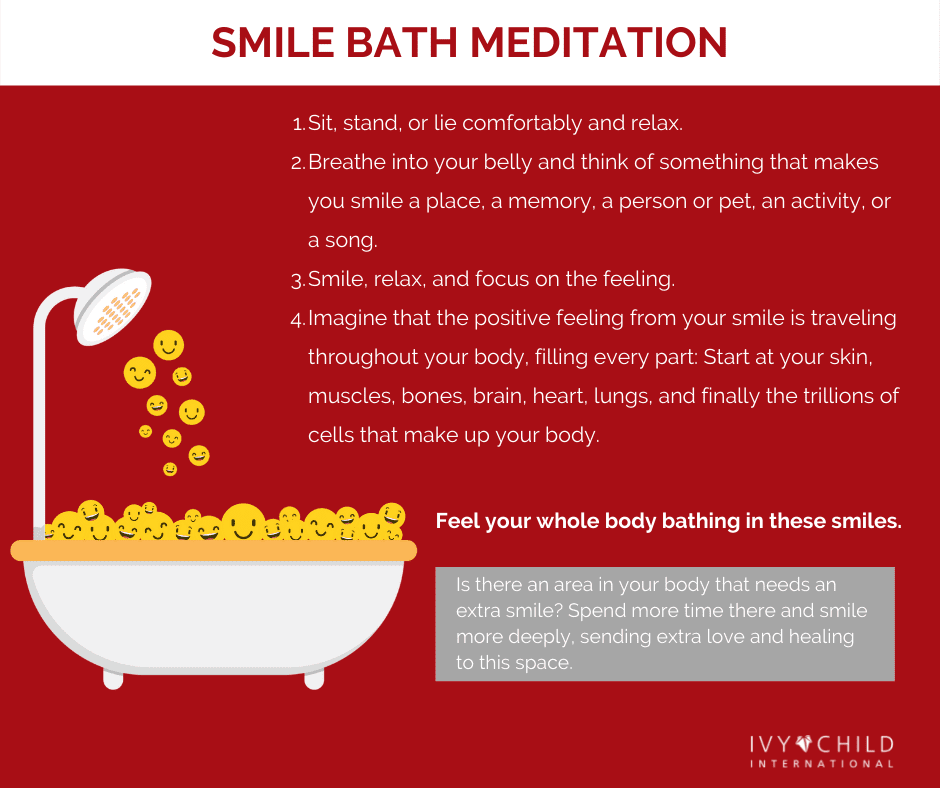
Sight
While in the tub, close your eyes or leave them open (whichever works for you). Visualize a water scene that is relaxing to you. Maybe sitting on a beach, floating in a pool, lounging by a lake. Imagine you are in that scene; delight in all that you see as you are transported to that place.
Hearing
What sounds bring you peace in your imagined scene? The crashing of waves, birds singing, the gentle rustle of leaves, people laughing. Call them forth as you shut out the noisiness of the day.
Smell
Your tub serves as the conduit to bring your thoughts into your present surroundings. Allow your mind to recall the pleasing smells that permeate your senses, the salty air, or maybe barbeque on the grill as you sit poolside.
Touch
As you picture your water scene, imagine the tactile sensations, the coolness or warmth of the water, the sand touching your skin, the grass beneath your feet, or the feel of the sun on your face.
Day 3 Bumblebee Breath
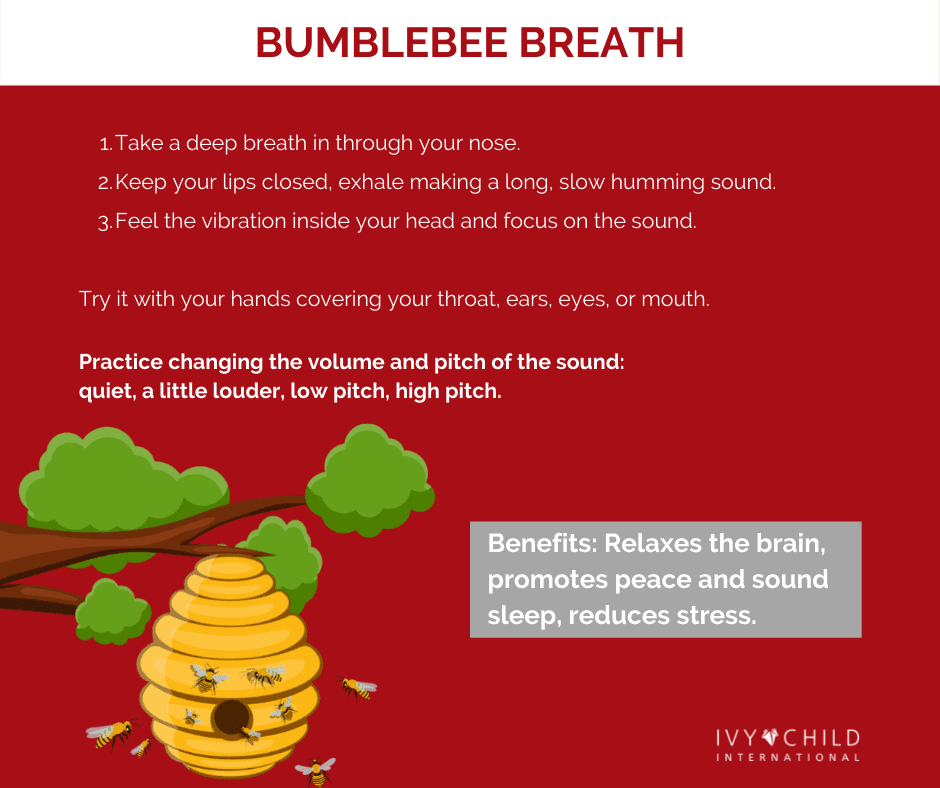 Anxiety is commonly associated with short, tight upper-chest breathing whereas relaxation, on the other hand, comes with slower breaths that originate from the diaphragm. Lengthening exhalation relative to inhalation reduces the ‘fight or flight’ impulse and maintains a healthy level of carbon dioxide in the blood, which helps you relax.
Anxiety is commonly associated with short, tight upper-chest breathing whereas relaxation, on the other hand, comes with slower breaths that originate from the diaphragm. Lengthening exhalation relative to inhalation reduces the ‘fight or flight’ impulse and maintains a healthy level of carbon dioxide in the blood, which helps you relax.
For anxiety, Bumblebee Breathe technique, also known as brahmari, Sanskrit word that means “bee, is an excellent technique. The practice is named for the humming sound that bees make. The sound is soothing for a spinning mind, and the practice lengthens the exhalation without excessive strain.
Bumblebee Breathe can be used as a regular daily practice to encourage relaxation or as an on-the-spot remedy. It works on calming the nerves and soothes them especially around the brain and forehead. The humming sound vibrations have a natural calming effect.
The longer you sustain the humming exhalation, the more relaxing the Bee Breath is likely to be—but forcing the breath beyond your capacity can have the reverse effect, causing even more stress. So don’t force yourself to maintain any particular speed. Inhale whenever necessary, and let the buzzing sound last as long as it is comfortable. Finally, spend a few breaths sitting quietly and noticing whether there are any changes in your breath or mood.
Day 4 Mood – Food Mindfulness
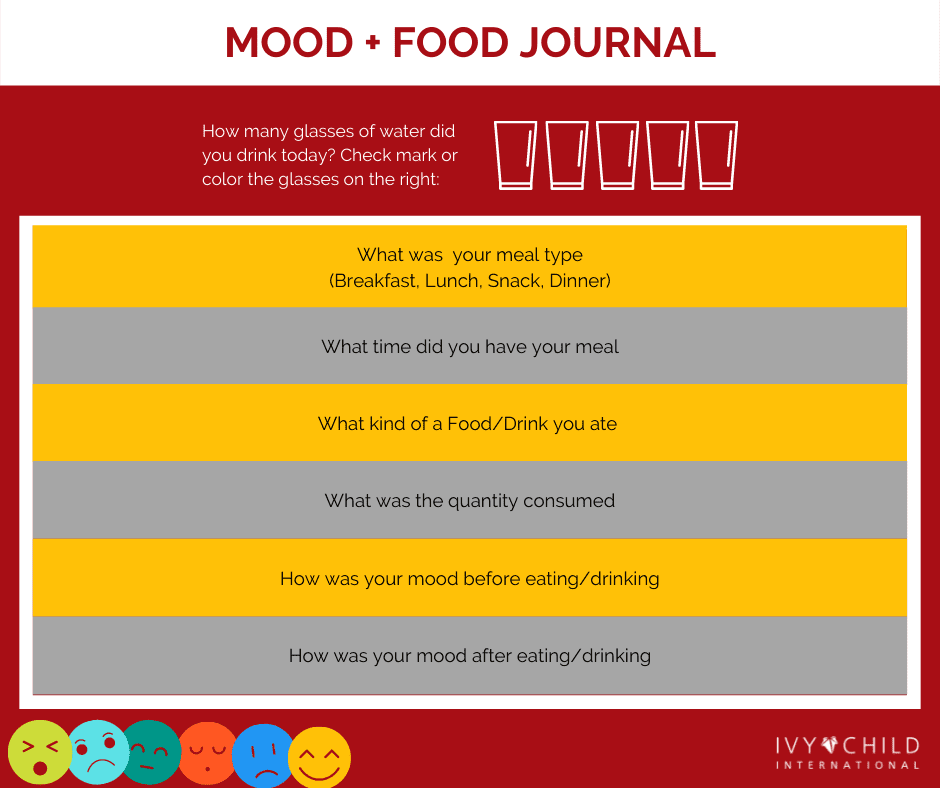 Ever feel down and just don’t know why? Do you know the TYPE of food you eat, and HOW you eat, directly affects your physical and emotional well-being? Research shows a clear connection between the food you eat and the gut microbiome, your inner eco system that governs your mood.
Ever feel down and just don’t know why? Do you know the TYPE of food you eat, and HOW you eat, directly affects your physical and emotional well-being? Research shows a clear connection between the food you eat and the gut microbiome, your inner eco system that governs your mood.
Mood – Food Mindful eating is maintaining an in-the-moment awareness of the food and drink you put into your body. It involves observing how the food makes you feel and the signals your body sends about taste, satisfaction, and fullness. Mindful eating requires you to simply acknowledge and accept rather than judge the feelings, thoughts, and bodily sensations you observe. It can extend to the process of buying, preparing, and serving your food as well as consuming it.
Mood – Food Mindful eating isn’t about being perfect, always eating the right things, or never allowing yourself to eat on-the-go again. And it’s not about establishing strict rules for how many calories you can eat or which foods you have to include or avoid in your diet. Rather, it’s about focusing all your senses and being present at that moment
Eating mindfully can help you to:
- Slow down and take a break from the hustle and bustle of your day, easing stress and anxiety.
- Examine and change your relationship with food—helping you to notice when you turn to food for reasons other than hunger, for example.
- Derive greater pleasure from the food you eat, as you learn to slow down and more fully appreciate your meals and snacks.
- Make healthier choices about what you eat by focusing on how each type of food makes you feel after eating it.
- Improve your digestion by eating slower.
- Feel fuller sooner and by eating less food.
- Make a greater connection to where your food comes from, how it’s produced, and the journey it’s taken to your plate.
- Eat in a healthier, more balanced way.
Day 5 – Starfish Meditation
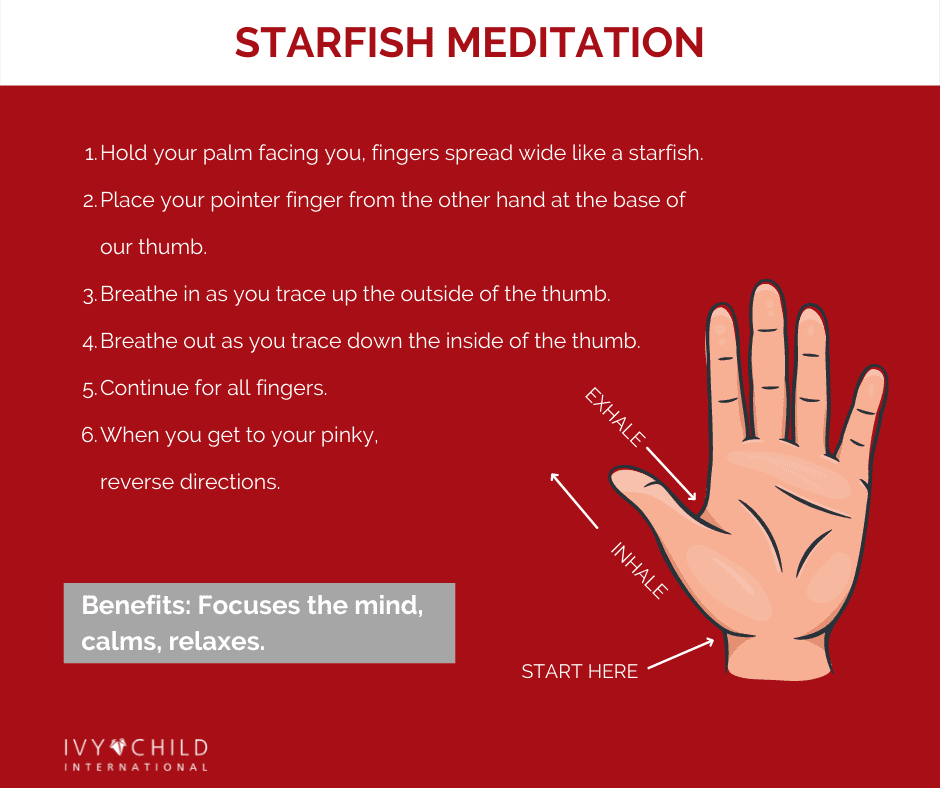 Starfish meditation is a way to build resilience to stress, anxiety and anger. Since all these reactions can impair not only our health but also our judgment and skills of attention. Several researchers & practitioners suggest that practicing starfish meditation is an effective way to deal with difficult feelings.
Starfish meditation is a way to build resilience to stress, anxiety and anger. Since all these reactions can impair not only our health but also our judgment and skills of attention. Several researchers & practitioners suggest that practicing starfish meditation is an effective way to deal with difficult feelings.
Starfish meditation technique is also known as “5-Finger Breathing”. To attain mindfulness, our first exercise focuses on the process – as you breathe in and out, you have to trace around your fingers.
Basically what you have to do is:
- Choose a hand to be your starfish. Extend this hand, palm out, with fingers spread like a starfish.
- Use the pointer finger from your other hand to trace the starfish as you breathe. Start at your thumb, and as you breathe in, trace up your thumb to the top. Do this carefully, so your movement matches your inhale.
- Now, with your out breath, trace down the inside of your thumb. Again, move slowly paying attention to keeping the breath and movement together.
- Continue breathing up and down each finger, matching your movement with your breath. As you breathe and trace, notice the sensations of movement in your body – your chest and belly moving in and out and your finger moving up and down.
- When you come to the base of your wrist below your little finger, rest for a moment. Check in with yourself. Notice how you are feeling without overthinking or judging.
- Try this again with your other hand.
Day 6 Jelly Arm Breath
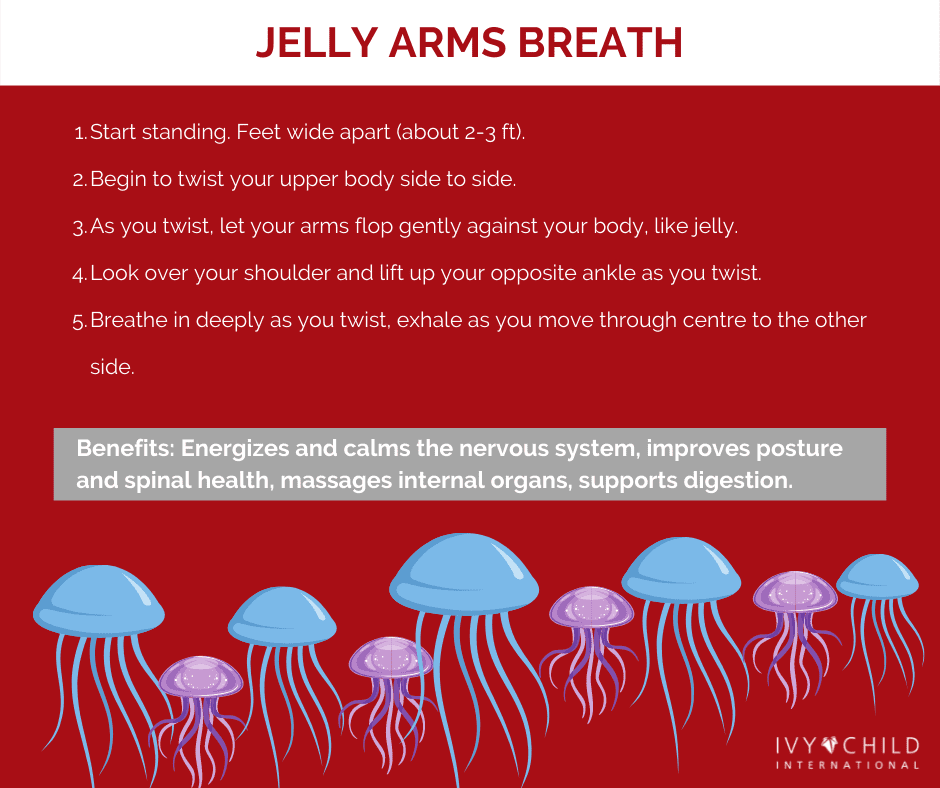 Jelly Arm Breath technique is part of Kundalini yoga and is meant to move energy through the body. It is based on the concept that energy at the base of the spine (also known as the root chakra) needs to be released through the seven chakras of the body and then out through the crown chakra above the head.
Jelly Arm Breath technique is part of Kundalini yoga and is meant to move energy through the body. It is based on the concept that energy at the base of the spine (also known as the root chakra) needs to be released through the seven chakras of the body and then out through the crown chakra above the head.
This process of releasing energy from the body has the purpose of creating a system of communication between your mind and body to relieve mental, physical, and spiritual issues. This system of bringing awareness to your body by connecting with your breath is intended to facilitate being present, establishing a new rhythm, and communicating with a higher version of yourself.
It’s a method to rejuvenate after a stressful day, manage stress in the moment, and/or counteract tiredness. It also aims to help balance your energy and calm your mind so that you’re acting with purpose rather than just reacting to your thoughts and environment.
Day 7 – Alternate Nostril Breathing
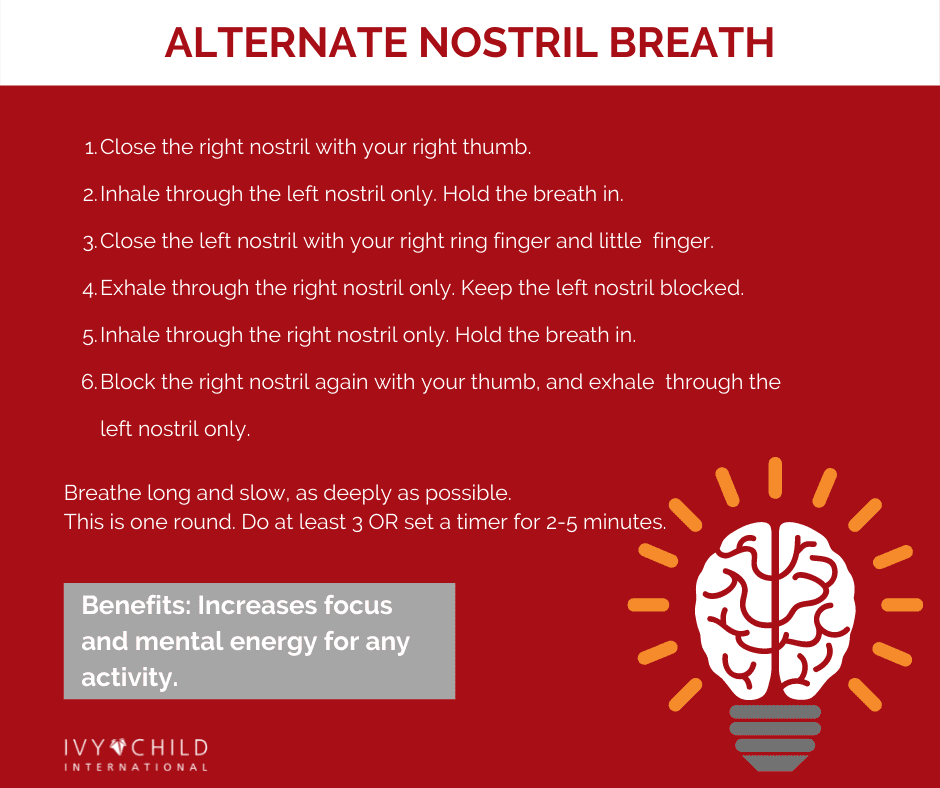 Alternate nostril breathing is a yogic breath control practice. In Sanskrit, it’s known as nadi shodhana pranayama. This translates as “subtle energy clearing breathing technique.”
Alternate nostril breathing is a yogic breath control practice. In Sanskrit, it’s known as nadi shodhana pranayama. This translates as “subtle energy clearing breathing technique.”
Alternate-nostril breathing doesn’t just belong to yoga, though. It’s often used in mindfulness and relaxation methods to help calm the body and the mind.
As the name suggests, alternate-nostril breathing is the focused practice of breathing through alternate nostrils, one side at a time.
How to Do Alternate-Nostril Breathing
If you want to try alternate-nostril breathing, here’s what to do:
- Sit quietly somewhere you don’t need to give any tasks your full attention.
- Bring your right hand up to your nose and move your forefinger and middle finger out of the way. Place your thumb on your right nostril.
- With this nostril covered, close your eyes and exhale fully and slowly through your left nostril.
- Once you’ve exhaled completely, release your right nostril and put your ring finger on the left nostril.
- Breathe in deeply and slowly from the right side. Make sure your breath is smooth and continuous.
- Once you’ve inhaled completely, exhale through your right nostril.
- Release your ring finger and close your right nostril with your thumb again. Breathe in fully and exhale fully from your left nostril.
- Repeat the full process two or more times.

